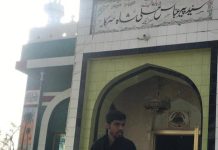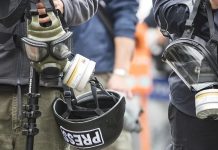KARACHI: Muhammad Ghani, a labourer from a remote village in Western Afghanistan moved to Pakistan in 2001 along with his family followed by the operation as a part of “War on Terror” launched by U.S led coalition in Afghanistan’s Tora Bora in search of Osama Bin Laden, the founder of Al-Qaida.
After crossing Pak-Afghan border, like many other Afghan refugees, he rushed to port city of Karachi. Many years after his arrival, Ghani wedded to an Afghan refugee’s lady in Karachi. In February 2017, a baby boy was born; who was latter named Muhammad Qasim.
Later Ghani and his wife wound that Qasim is not moving his leg properly. They rushed to the doctor and doctors apprehended that he might be suffering with polio (poliomyelitis). They sent his report for laboratory test and on September 08, 2017, the test confirmed that Qasim was suffering with polio virus.
Before, confirmation of this case, officials working on polio eradication were satisfied that they are near complete eradication of polio virus from Pakistan, as since January 2016 there had no any new case of polio was reported in Pakistan’s biggest city of Karachi, which was remained a hub of the virus in the past.
Ghani lives in Karachi’s Tora bora Colony, a slum, where government departments are not providing basic facilities like proper sanitation and drinking water.
“We get water that is contaminated with sewer,” he told News Lens Pakistan.
“His family used to refuse polio vaccine and we were only able to vaccinate this child on one occasion,” said Fayaz Ahmed Jatoi, coordinator for polio in Sindh.
With the time elapsed between the cases, health experts were cautiously optimistic that the region would soon be declared polio-free, as it was over half-way across the three-year mark set by the World Health Organization (WHO). Now, the clock has been reset and the city’s next chance of being declared polio-free will be in 2020.
Pakistan is among the three countries, the others being Nigeria and Afghanistan, that are still fighting against polio.
For decades, health authorities in the country have focused efforts to eradicate polio through immunization, while largely ignoring the contaminated water supply that acts as the vector, as experts believe that sewer contaminated water is a major source of dissemination of polio virus. A recently conducted research study of Pakistan Council of Research in Water Resources (PCRWR), an official body working on water related issue, stated that the Karachi’s water supply is mixed with sewage water
In Karachi, many areas, specifically slums settlements, which deprive basic civic facilities like clean drinking water and proper sanitation system. This scribe visited many areas including Tora Bora Colony, Chanesor Goth (Jamshed Town), Garib Abad, Gutter Baghicha (Lyari), and Machar Colony where availability of clean drinking water rarely. These low income areas are hit by polio and waterborne disease too.
In last few years Pakistan remained one of the only three countries in world where polio virus exists, after which Pakistan worked alot on refusal case and security issued faced by polio workers, however, sewer mixed contaminated water is serious obstacle for Pakistan.
“Sewer drinking water is the major source of polio virus transmission, however most of the people underestimate that contaminated water is not source of polio virus” disclosed Dr Iqbal Ahmed Memon, National Representative at the National Immunization Technical Advisory Group (NITAG).
“The Polio virus survives six weeks in faeces and three weeks in human throat,” explained Memon.
The polio virus strain discovered in the majority of cases reported in Karachi originated in the Quetta Block and was brought to the city with the influx of Pashtoon and Afghan refugees, according to the polio eradication officials.
These migrant families settled in low income areas, the slums, of the city with no drinking water and sanitation system.
A recent study by the Emergency Operations Centre—EOC found that of the 18 samples collected from Karachi’s drainage system, between June and August 2017, 14 samples contained traces of the Wild Polio Virus (WPV), which can cause infections in the body of the victim.
For Jatoi, the possibility of the presence of the WPV strain in Karachi’s water supply cannot be ruled out. Typically, the virus enters the body orally and multiplies inside the gut, he added.
Due to the outdated water supply system, in Karachi, at many places, the sewage mixes with drinking water, contaminating it with polio virus. Surprisingly, the officials are collecting environmental samples from sewerage system but not from drinking water.
However, Jatoi justified saying that the test result is ‘better’ in sewerage samples, than drinking water.
However it cannot be diagnosed to confirm, how virus entered either by water or food, by genetic sequencing just to confirm origin of Virus, he added.
Dr. Murtaza Arain, a research officer at the Pakistan Council of Research in Water Resources (PCRWR) quoting the report said that the Karachi Water and Sewerage Board’s (KWSB)’s method of chlorination is inadequate, marred by poor system and lack of proper equipment.
According to Arain, the study tested 118 samples from the supply chain in different parts of the city. Of those tested, 107 samples were found to be unfit for human consumption. At least 40 showed the presence of the bacteria, e coli, which points to the presence of faeces in the water widely.
Official data of KWSB, the only government agency responsible for the supply of water in the city, that KWSB supplies 550 million gallons per day (MGD) water to the city.
For these 550 MGD, the KWSB operates only five filter plants, which have a capacity of 250 MGD. The remaining is unfiltered, said the board’s Managing Director Hashim Raza Zaidi.
These pipelines have been punctured on numerous locations to obtain illegal connections to draw water, he added.
The KWSB simply does not have the manpower or resources to clamp down on these illegal connections along the thousands of kilometers of supply chain, decried Zaidi. Further, the replacement process of these pipelines will cost a fortune – a fortune that the KWSB simply does not have at the moment.
Zaidi said despite the lack of proper equipment and resources, the KWSB was trying its best to improve the quality of water by adding chlorine at various points. The quantity of chlorine is significantly reduced at the consumer’s end due to the long distance of the pipes and leakages through illegal connections.
Dr. Arain, however, had a different view. The PCRWR researcher explained that the water is chlorinated only at the primary level, which is why the standard level of chlorine is not maintained till the ending. He suggested adding chlorine at each pumping station to maintain the chlorine levels.
The situation is worse if sewage water is being mixed with the water supply. “Polio will never be eradicated and all immunization efforts will be futile,” said Dr. Iqbal Ahmed Memon.
Fact Sheet of WHO also point out that contaminated water is one of the cause for Polio transmission, contaminated water carried out virus of Poliomyelitis .
One of the cheapest and most effective ways to ensure the supply of clean potable water is to treat it with chlorine – a chemical that kills most of the bacteria and viruses, according to water experts.
Former Administrator of Metropolitan city Karachi Faheem-Uz-Zaman said that city has substandard drainage system, which caused the contamination drinking water, that contamination is one of the root causes of water borne disease in city, he added.
He said that drinking water is being contaminated by sewage while supply doesn’t run, punctured pipes sucked sewage water, because drainage passed by water supply lines, he added.
In Karachi, mostly the poor live in un-regularized slums and they do not have access to state supplied drinking water and these slums are the places where water mixes with sewage.
Statistics obtained Kachi Abaadi Authority (KAA) that regularized peri-urban residential area; around two thousands one hundred Kachi-Abadees are encroached on government land which have no proper system of water supply and sanitation.
Syed Riaz-Ud-Uddin Deputy Director of KAA said that only 520 out of 2100 Kachi-Abadis are in master plan for regularization as their legal status, rest of these are illegal, he added.
He said that around 45 percent population of city settled with the remit of illegal settlement, they fulfill their basic amenities on their own. We received numerous complains of illegal connections of water there which are not our domain said deputy director KAA.
Resident of Baldia Town Salman Mujahid Baloch, who filed petition before Judicial Water Commission formed on the directives of Supreme Court of Pakistan in December, 2016 to ensure supply of clean drinking water in province.
Petitioner said that residents of Baldia Town didn’t get drinking water because water diverted through illegal supplied system by influenced culprits.
According to report of national emergency action plane (NEAP) for polio eradication 2016-17 that nine countries were among the affected of wild polio virus (WPV) during 2014, these nine countries accounted 359 confirmed WPV. After successful eradication campaign throughout world only three countries Pakistan, Nigeria and Afghanistan are with WPV currently.
Statistics of NEAP shows that during eradication campaign number of WPV is declining steadily.
According to NEAP 198 polio cases were reported after successful eradication campaign in 2011; further number cases reduced during 2012, only 58 cases were reported. Polio cases increased slightly by 98 cases in 2013 and 306 during 2014, again it declined in 2015 and 2016 with 54 and 13 cases respectively.
Along with immunization campaign, there is acute need evolving strategy for prevention also, authorities should have carried out both eradication and prevention campaign, prevention measures should be adopted on war footing, to stop supply of faeces mixed water in city, said Dr. Ajeet Kumar, renowned general physician
Fluctuation in polio cases yearly, it shows authorities would focus for prevention particularly to ensure clean drinking water which is source of virus transmission, he added.



